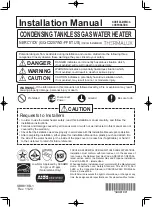
Form RZ-NA-I-LDAP, P/N 207733 (Rev 2), Page 20
Continuous Fan
Operation
remain energized for an inter-purge period of 10 seconds. The spark and gas valve are
then re-energized, and the control initiates another trial for ignition.
If flame is not established on the second trial for ignition, the control de-energizes the gas
valve, energizes the fan motor on heat speed, and the heat section venter motor and main
venter motor remain energized. The fan motor is shut off after the longest selectable fan
delay time (160 seconds). When the fan motor de-energizes, the spark and gas valve are
re-energized and the control initiates another trial for ignition. (This fan delay is a self-
healing feature for an open auxiliary limit switch).
If flame is not established on the third trial for ignition period, the control de-energizes
the gas valve, and the heat section venter motor and main venter motor remain energized
for an inter-purge period of 10 seconds. The control then re-energizes the gas valve and
spark and initiates another trial for ignition.
If flame is not established on the fourth trial for ignition (initial try plus 3 re-tries), the
control de-energizes the gas valve and goes into lockout. The control goes to one flash on
the green LED to indicate ignition failure lockout.
Limit and High Limit Switch Operation
- The high limit and limit switch are ignored
unless a call for heat is present (W energized). If the high limit or limit switch are open
and a call for heat is present, the control de-energizes the gas valve and turns the fan
motor on heat speed and runs the heat section venter motor and the main venter motor.
When the switch re-closes or the call for heat is lost, the control runs the heat section
venter motor and main venter motor through post purge and runs the fan motor through
the selected fan off delay. The control will return to normal operation after fan off delay
is completed.
Heat Section Pressure Switch (all sizes) and Main Combustion Air Pressure Switch
(Sizes 800 and 1200)
- If the heat section pressure switch or main combustion air pres-
sure switch opens before the trial for ignition period, the heat section venter motor and
main venter motor will run through the heat section pressure switch and main combus-
tion air pressure switch recognition delay (2 seconds), the gas valve will be de-energized,
and the heat section venter motor and main venter motor will run through the postpurge
time. The control will re-start the heat cycle at the heat section pressure switch and main
combustion air pressure switch proving state if the call for heat still exists.
Heat section pressure switch or main combustion air pressure switch opening for less
than 2 seconds during the trial for ignition period shall not interrupt the heat cycle. (Gas
valve will de-energize while the heat section pressure switch and main combustion air
pressure switch is open.)
If the heat section pressure switch or main combustion air pressure switch opens after a
successful ignition, the control will de-energize the gas valve. If flame is lost before the
end of the 2 second pressure switch recognition delay, the control will respond to the loss
of flame. If the heat section pressure switch and main combustion air pressure switch
remains open for 2 seconds and the flame remains, the control de-energizes the gas valve,
the heat section venter motor and main venter motor runs through postpurge, and the fan
motor runs on heat speed through the selected fan off delay. When the fan off delay is
over, the fan motor is de-energized, and a heat cycle is begun if the call for heat still
exists.
When the thermostat calls for continuous fan (G) without a call for heat, the fan motor is
energized after a .25 second delay. NOTE: This brief on delay is to allow the “G” termi-
nal to energize slightly before “Y” and an external changeover relay to switch from “G”
to “W” without causing momentary glitches in the fan motor output. The fan remains
energized as long as the call for fan remains without a call for heat.
If a call for heat (W) occurs during continuous fan, the fan will de-energize.
A call for fan is ignored while in lockout.
20. Ignition
System
(cont’d)
Abnormal Heat
Cycle Functions
(cont’d)
















































